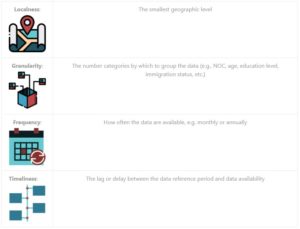
Balancing Act: Considering Trade-Offs for Improving LMI
Labour Market Information Needs to Evolve in Parallel to the Challenges at Hand
When federal and provincial ministers responsible for labour markets first endorsed the creation of a new Labour Market Information Council (LMIC), one of the core aims was to address the need for more local, granular data. In a country as large as Canada — where certain groups are often affected disproportionately (granular) and challenges and opportunities are often sub-regional (local) — this made sense.
On top of that, in the past few years, the growth of new technologies including AI, has rapidly changed how information is consumed and shared. These developments have only reinforced the need for information that is also timely and frequent.
This means that the insights and information we provide to support Canadians in their decision-making processes must not only be relevant to them (local and granular) but also reflective of the speed at which the nature of work is changing (timely and frequent).
We know from our public opinion research that Canadians want more detailed and up-to-date information that is also forward looking. As a provider of labour market information, the challenge for LMIC and its partners is in how to balance the various dimensions of data, keeping in mind the needs of end users. Considering that goal, together with Statistics Canada we have begun by defining and assessing the key dimensions of available labour market data.
Shared Understanding: What We Aim to Achieve
In our first year at LMIC, we consulted stakeholders about their labour market information needs in an effort to better gauge what was missing with respect to four key data criteria: localness, granularity, timeliness, and frequency.
We learned very quickly that there is a lack of understanding about what is meant by each of these terms. Working with our colleagues at Statistics Canada, we developed definitions so that all parties could speak the same language when evaluating labour market information.
Table 1: Four Comparison Criteria of LMI

Source: Young Jung’s blog “Local, Granular Data for Beginners.”
Although not mentioned in these four criteria, the reliability of labour market information is also crucial. Reliability is assumed to always be at, or above, a statistically robust and representative level. This requirement imposes, in effect, a limit on how far any one dimension of the data can be taken.
Trade-Offs: “All the surveys in the world won’t solve this problem”
To begin, we obtained a better sense of stakeholder needs as they relate to each of the dimensions of labour market information described above. We then set out with Statistics Canada to assess the prevailing situation against these four data dimensions. Our aim was to evaluate different approaches to getting better labour market information.
The results of our preliminary evaluation are described in greater detail in LMI Insights No. 15. But two findings are important to bear in mind when thinking about improving labour market data.
First, survey-based approaches, even ones that leverage existing infrastructure, are no panacea. In fact, new or expanded surveys could compromise the collection of existing data.
Second, and critically, there is no single option for improving the overall quality of labour market data that can elevate all the dimensions of localness, granularity, timeliness, and frequency. Trade-offs must be made between these four dimensions.
For instance, more granular and localized information will take time to collect and process, which will affect the timeliness and frequency of the data. A balance that considers the intended-use cases of the resulting data must be struck.
In other words, in some cases, granularity will be more important than timeliness (think census data). In other cases, frequency may take precedence over localness (think monthly unemployment rates from the Labour Force Survey). In all instances, these must be weighed against the financial costs of any approach.
Moving Forward: Leveraging Existing Data to Close the Gap
With these considerations in mind, LMIC and Statistics Canada will begin working to assess the possibilities that modelling approaches, such as small area estimation techniques, can offer.
Our plan is to take advantage of existing labour market information and assess the extent to which we can close the gaps. In this way, we can leverage the benefits of prevailing sources of labour market information — such as the frequency of the Labour Force Survey and the granularity of the census — in order to generate new data that merges the best aspects of different data sources.
Crucially, we must always keep in mind the end user. That is why we will continue to engage with our stakeholders to ensure that any estimates generated are relevant and lead to meaningful improvement over what already exists.

Steven Tobin is the Executive Director of the Labour Market Information Council. Steven provides the overall strategic leadership and management to the LMIC with the guidance of the Board of Directors and two advisory panels.